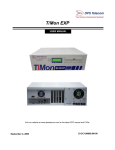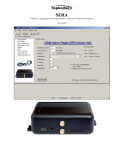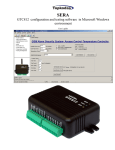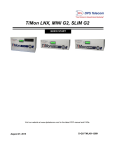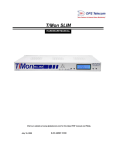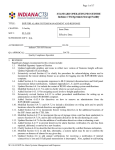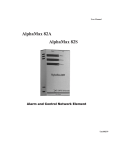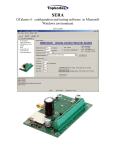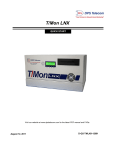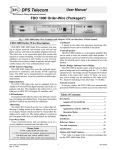Download DPM, DPM-216, and DCM
Transcript
DPM & DPM-216 USER MANUAL May 21, 2009 D-OC-UM09.521200 Firmware Version - DPM: 2.1I Firmware Version - DPM216: 1.0A Revision History May 21, 2009 Released updated D-OC-UM09.521200 March 12, 2009 Released updated D-OC-UM093.12100 January 23, 2009 Released D-OC-UM09.23100 This document contains proprietary information which is protected by copyright. All rights are reserved. No part of this document may be photocopied without prior written consent of DPS Telecom. All software and manuals are copyrighted by DPS Telecom. Said software and manuals may not be reproduced, copied, transmitted or used to make a derivative work, by either mechanical, electronic or any other means in whole or in part, without prior written consent from DPS Telecom, except as required by United States copyright laws. © 2008 DPS Telecom Notice The material in this manual is for information purposes and is subject to change without notice. DPS Telecom shall not be liable for errors contained herein or consequential damages in connection with the furnishing, performance, or use of this manual. Contents Visit our website at www.dpstelecom.com for the latest PDF manual and FAQs 1 DPM and DPM-216 1 1.1 About This Manual 1 1.2 Overview 1 1.2.1 2 Possible Applications 1.3 Specifications 3 1.4 Technical Description 4 1.4.1 DPM only 1.5 Echo Mode Applications 5 5 1.5.1 DPM in Echo Mode 5 1.5.2 DPM-216 in Echo Mode 6 1.6 Installation 7 1.7 Hardware Connections for the DPM and DPM-216 8 1.8 Alarm Input Tutorial 9 1.8.1 Dry Contacts 10 1.8.2 Contact to Battery 10 1.8.3 Contact to Ground 11 1.8.4 TTL Output 11 1.9 How To Read Pager Displays (For the DPM only) 12 1.9.1 Alphanumeric Pager 12 1.9.2 Numeric Pager 12 1.9.3 ASCII Terminal 13 1.10 Operation 13 1.10.1 For the DPM only 14 1.10.2 ASCII Control (228-Series Models) 16 1.11 LED Display Descriptions 18 1.12 Reference Section 19 1.12.1 For the DPM only 20 1.12.2 Troubleshooting 20 2 Technical Support 21 3 Warranty 22 4 End User License Agreement 23 1 1 DPM and DPM-216 1.1 About This Manual There is a separate user manual for T/DPMW. You are reading the hardware manual for the DPM and DPM-216. This Hardware Manual provides instructions for hardware installation and operating the unit. The T/DPMW User Manual, included on the Resource CD, provides instructions for provisioning and monitoring the DPM and DPM-216 using the software utility. 1.2 Overview Fig. 1 - The compact design of the DPM and DPM-216 allow for mounting on any flat surface. The Discrete Point Module (DPM) DPS’s Discrete Point Module, teamed with your local pager service, will let you know when you have an important event occurring at some isolated location. The DPM can detect any event that can be translated into an electrical contact closure, such as a micro switch or relay. Door openings and equipment failures are typical events that it can report to your pager or cell phone. In addition, you can contact the DPM from any tone dialing telephone and, by password identification, activate remote devices like door locks or security lights. The Discrete Point Module 216 (DPM-216) The Discrete Point Module 216 is connected to a central monitoring device via a dedicated communications facility. The DPM-216 is a fixed-facility version of the DPM, with RS232, RS422, RS485 or 202 Modem interface. These are the main differences between the DPM and DPM-216. The DPM-216 can also detect any event that can be translated into an electrical contact closure, such as a micro switch or relay, to notify you of important events. DPM Features: · Pages you when critical events occur · 16 Alarm inputs, 2 control outputs · Supports both alpha and numeric pagers DPM-216 Features: · Notifies the central monitoring station of critical events · 16 alarm inputs, 2 control outputs · Compact, economical package 2 · · · · · · · · Compact, economical package DTMF phone control Interface large networks via dial facility Reports to IAM or T/MonNOC Masters Download configuration from a PC Automatically operate derived controls Optional ASCII craft port access AC or DC powered · · · · · · Interface large networks via dedicated facility Reports to IAM or T/MonNOC Masters TBOS or DCP family protocols Download configuration from a PC AC or DC powered Non-volatile RAM maintains configuration when off Configuration Software The DPM has programmable features such as back-up pager numbers and written alarm point descriptions. The DPM-216's programmable features include alarm descriptions and polarity. Configuring these features is easy using T/DPMW, a Windows-based software provided with the unit at no extra charge. Programming is done locally through the serial port of a computer (for both units) or by dialing the DPM from any modem-equipped PC (DPM only) The software will also monitor the alarm states and operate control relays. To download T/DPMW, go to www.dpstele.com/support. Login and click on the "Firmware / Software Downloads" button. Derived Controls In addition to being activated remotely, control relays may be activated internally by a combination of existing alarms, using a programmable equation (derived control). Each control point may have up to two equations defined. For example, maybe you'd like to toggle a relay every time a door alarm is triggered. ASCII Craft Port Access Some models of the DPM allow you to connect a remote computer through DPM port to an ASCII craft port on another piece of equipment, such as a PABX or channel bank. Discrete Control Module The Discrete Control Module (DCM) is a full complement to the DPM and DPM-216, providing 2 alarm points and 16 controls. 1.2.1 Possible Applications Telecommunications - The DPM is just right for remote cell sites and small offices, where 16 alarms and 2 controls are sufficient. In addition to pager reporting, the DPM may forward elected alarm points to a central network management system. The DPM dials the master and reports with TRIP protocol or ASCII messages. The DPM-216 contacts the master and reports with TBOS, DCP, DCPf, or DCPs protocol via RS232, RS422/485 or 202 modem on dedicated facility. Agriculture - A DPM or DPM-216 in a barn or other out-building can notify you of an unauthorized entry, temperature extreme, fire, low water pressure, pump operation, etc. With the DPM’s remote control capability you can operate door locks, security lights and pumps. Refrigeration - The DPM and DPM-216 can monitor freezer doors, temperature sensors, compressor operation and power lines to warn off-site personnel of impending problems, before they cause significant losses. Fire and Safety - The DPM and DPM-216 can monitor smoke and sprinkler pressure alarms, door and window openings in industrial and commercial facilities, pin-pointing trouble spots for responding emergency teams, 24 hours a day. 3 1.3 Specifications Alarm Point Inputs Uni-polar inputs. TTL Inputs Dimensions Relays Mounting Power Input Fuse Heat Dissipation Modem DPM Protocols DPM-216 Protocols Connectors Comm. Facility Interface (For the DPM-216 only) Operating Temp. Humidity LEDs 16 optically-isolated bi-polar inputs. (Connect to Gnd and Batt to alarm.) (OPTIONAL; Close contact across terminals to alarm.) (OPTIONAL) Referenced to +5 VDC through 2.2K ohm resistor Ground one side of input through TTL circuit to alarm 7.0"(L) X 5.0"(W) X 1.5"(D) 2, Form “A” Rated Load = 0.5A 125VAC, 1A 24VDC Contact Material = Gold-Clad Silver Max. Switching Power = 62.5VA, 30W Max. Switching Current = 1A Max. Switching Voltage = 60 VDC/125 VAC Max. Carrying Current = 2A Two keyhole mounting holes on back vertically spaced 1.75" apart. 21ma @ +/-48 VDC (1 Watt) 42ma @ -24 VDC (1 Watt) 84 ma @ +/-12 VDC (1 Watt) A 120 VAC wall mount transformer is supplied with the -24 VDC unit. 125 mA. 35 BTU @ 24 or 48 VDC 212 “AT Type” 300/1200 Baud DTMF/Internal modem with DTMF Receiver Optional 2400 Baud modem. T/Mon Remote Interface Protocol (TRIP), TAP Protocol (for Alpha Pagers), Numeric Pager, text message to cell phone, ASCII (Optional) TBOS, DCP, DCPf, DCPS Line = RJ12 (J5) Configuration or ASCII = Female DB9 (J3) - RS232 or RS485 (optional) Alarm/Control Points = Female DB37 (J1) Power = 3.5 mm Mono Jack or screw on (optional) (J4) Unused = Male DB9 (J2) RS232 (Option 1V) 202 - 1200 Baud modem (Option 2V) RS422/485 (Option 4V) 0 degrees to +60 degrees Celsius (32 degrees to 140 degrees F) 0% to 95% non-condensing Shipping Weight - 4 lbs. 14 front panel 4 1.4 Technical Description The DPM and DPM-216 use a central microprocessor and interface circuitry for inputs/outputs. Be careful to observe the polarity option for your unit. Alarm Inputs The opto isolated alarm inputs are normally alarmed” when current is flowing. Alarm points can be individually reversed with the T/DPMW software to be “unalarmed” when no current is flowing. Each input can be configured for unipolar operation (reports going to alarm state only) or bi-polar operation (reports both going to alarm state and returning to cleared state). Each point can have a 30 character description, a qualification time period, backup reporting device number and redial function. Up to four reporting device dial-out numbers can be stored. The bi-polar inputs have both sides of the opto isolator brought to the connector, permitting ground or battery activation. (Refer to the input wiring details in Fig. 4 and to the Alarm Input Tutorial. "Bi-Polar Inputs" can be positive or negative.) Control Outputs Form-A contacts are provided, with normally open (N.O.) contacts brought out to pins on connector J1. Bi-polar Operation and Unipolar Operation describe COS reporting methods. Bi-Polar input describes the electrical interface at the alarm input. Fig. 2 – Block diagram/ functional schematic 5 1.4.1 DPM only Alarms Sent to Pagers or Alarm Center Reporting Devices -In the event of an alarm, the DPM dials out to either an alpha or numeric pager that displays the alarm message. It can also call a monitoring center equipped with a DPS T/MonXM or IAM alarm system or an in-house custom monitoring system. An ASCII reporting version is available that reports alarms to an ASCII terminal or to a PC programmed to act as an ASCII terminal (model D-PC-221-11A-04). Fig. 3 Discrete Point Module reports alarms to a variety of devices. 1.5 Echo Mode Applications Fig. 4 – Echo application uses DPM and DCM back-to-back. 1.5.1 DPM in Echo Mode In this application the DPM communicates via dial line with a Discrete Control Module (DCM). When the DPM detects an alarm, it dials the DCM. The DCM relays that correspond to the alarmed points operate, following the alarm inputs point-for-point. Likewise, the DCM’s two alarm inputs operate the two respective relays at the DPM. This is especially useful in converting alarms between systems with unlike protocols or for transporting alarms from small remote sites to large, centrally located remotes or annunciator panels. An optional Wire Wrap Block with two DB27 cables may be purchased to aid installation. Individual alarm and relay lines are wire wrapped to the Wire Wrap Block and the DB37 cable is plugged into the DPM, eliminating 6 soldering. Block supports 2 units. 1.5.2 DPM-216 in Echo Mode In this application the DPM-216 communicates via a dedicated facility with a Discrete Control Module (DCM-216). When the DPM-216 detects an alarm, it reports directly to the DCM-216. The DCM-216 relays that correspond to the alarmed points operate, following the alarm inputs point-for-point. Likewise, the DCM-216’s two alarm inputs operate the two respective relays at the DPM-216. This is especially useful in converting alarms between systems with unlike protocols or for transporting alarms from small remote sites to large, centrally located remotes or annunciator panels. An optional Wire Wrap Block with two DB27 cables may be purchased to aid installation. Alarm and relay lines are wire wrapped to the Wire Wrap Block and the DB37 cable is plugged into the DPM, eliminating soldering. The block supports 2 units. 7 1.6 Installation 1. Unpack the DPM and all accessories. Check contents against the shipping list. The installer must provide alarm contacts (micro switches, relays, etc.) power source, and wires to the alarm and control points. 2. Mount the DPM. (Use enclosed mounting template and hardware.) 3. The DPM is shipped with all necessary cables for installation. These include the integral power cable/AC adaptor and the phone line cable. Refer to Fig. 5 in the Hardware Connections section to ensure a proper connection for each input. 4. Wire Wrap Block: If a wire-wrap block is used with the DPM, the next two steps will be performed. See wire-wrap manual for details. a.) Connect alarm points and controls to J1 on the DPM. A DB27 connector and hood are supplied with the DPM. Shunt J10 if power connects at the power jack and if pin 1 is used for biasing the alarm inputs to battery. b.) If using the wire-wrap block, plug the DB27 connector from the wire-wrap block into J1 on the DPM and connect the alarm and control points per the wire-wrap block operation guide. To operate an alarm, there must be a current path from the input pin to the alarm return pin. Example: To operate alarm point 5, pin 25 connects to negative battery (available at pin 1 - install J10 if the power jack is used), pin 6 connects to positive ground (available at pin 20) and the operating contact is placed in either leg. See Section 6. 5. If using the wire-wrap block, DC power may be taken through the wire-wrap block at pins F-1 (+) and F-3 (negative ground). This arrangement utilizes the fusing provided on the wire-wrap block. Power will come to the DPM through connector J1 and it will not be necessary to use the AC adaptor. 6. Connect the unit to the proper transport: a.) For the DPM: Connect the RJ12 phone line to the DPM. b.) For the DPM-216: Connect the RJ12 connector to the facility using the provided cable. The equipment end of the cable will need to be soldered to the appropriate connector (not included). 7. AC Power: Connect the power adapter to J4, then plug the adaptor into an AC outlet. If using a Wire-Wrap block, use J4 - do not run AC power through the block. Do not insert a "hot plug" into J4. 8. DC Power: If a DC supply is used power may be connected at J1 pin 1 (- BATT) and pin 20 (+ GND). The DPM can only be configured with T/DPMW software through the unit's COM1 port OR via phone line. The DPM 216 does not have a dialup modem and can only be configured with T/DPMW through the COM1 port. Fig. 5 – The DPM and DPM216 are configured with T/DPMW. 8 1.7 Hardware Connections for the DPM and DPM-216 Fig. 6 – Discrete Point Module hardware connections. 9 1.8 Alarm Input Tutorial Fig. 7 - Current flow causes alarm The DPM senses a change of state through current flow in the optical isolators. There are five types of alarm (current) sources for the DPM: dry contact, contact to battery, contact to ground, TTL outputs and dry contact (using DPM with internal jumper to battery). The first three types apply to “regular” DPM’s; the last 2 apply to special options. Use Table A to find the pins to use for each input for the five types of alarm sources. Table A - Alarm Input Connections for the Five Types of Alarm Sources 10 1.8.1 Dry Contacts · Bus the negative side of the optical isolators for all points that use “dry contact” sources (J1 – pins 21-35) to battery. (Battery is normally available at J1-1. If the DPM power is connected to the jack (J4), jumper J10 should be shunted.) NOTE: “Battery” is negative for -12, -24 and -48 volt options, positive for +12 and +24 volt options. Positive battery options use bi-directional optical isolators, allowing “battery” to be connected to the negative side of the opto. · Connect one side of the dry contact source to ground. (Ground at J1-20.) · Connect the positive side of the optical isolator for the desired alarm point to the other side of the dry contact. Fig. 8 – Dry contact source wiring. Dry Contact (DPM only - Using DPM with internal jumper to battery) Switch or relay with both leads at terminals. DPM inputs have one side of opto internally connected to battery, one input pin internally connected to ground. · On those DPM options that have an internal jumper to battery, it is not necessary to add any external jumpers. All inputs apply a contact across pins 2 & 21, 3 & 22, 4 & 23, etc. All inputs must be the same type with this option. Fig. 9 - Dry contact (internal battery) source wiring. 1.8.2 Contact to Battery · Bus the positive side of the optical isolators for all points that use “contact to battery” sources (J1 - pins 2-17) to ground. (Ground available at J1-20.) NOTE: “Ground” is positive for -12, -24 and -48 volt options, negative for +12 and +24 volt options. Positive battery options use bi-directional optical isolators, allowing “ground” to be connected to the positive side of the opto. · Connect the negative side of the optical isolator for the desired alarm point to the source contact. · NOTE: Input 16 cannot be used for this type of alarm source. 11 Fig. 10 – Contact to battery source wiring. 1.8.3 Contact to Ground · Bus the negative side of the optical isolators for all points that use “contact to ground” sources (J1 -pins 21-35) to battery. (Battery is normally available at J1-1. If the DPM power is connected to the jack (J4), jumper J10 should be shunted.) NOTE: “Battery” is negative for -12, -24 and -48 volt options, positive for +12 and +24 volt options. Positive battery options use bi-directional optical isolators, allowing “battery” to be connected to the negative side of the opto. · Connect the positive side of the optical isolator for the desired alarm point to the source contact. Fig. 11 – Contact to ground source wiring. 1.8.4 TTL Output DPM only: Transistor-Transistor Logic internally switches to negative ground. DPM inputs are internally biased to +5V. TTL source outputs require the TTL option. All sources must be TTL. Connect the alarm sources to pins 2 through 17. No jumpers are required. Fig. 12 - TTL source wiring 12 1.9 How To Read Pager Displays (For the DPM only) This section shows you what to expect when receiving pager notifications from alphanumeric and numeric pagers. You will also see where and how to define these pager properties using T/DPMW software. For more information, please see the separate user manual for T/DPMW. 1.9.1 Alphanumeric Pager Alphanumeric pagers show both Change of State (COS) and Status reports. Refer to Fig.13. The appearance of the report may vary depending on the pager and pager company, but the order in which the information is presented will remain the same. Fig. 13 - Alphanumeric pager shows both COS and Status Reports 1.9.2 Numeric Pager Numeric pagers also show Change of State (COS) and Status reports. Refer to Fig. 14. The appearance of the report may vary depending on the pager and pager company, but the order in which the information is presented will remain the same. Fig. 14 - Numeric pager shows both COS and Status Reports 13 Pagers Reference Guide for T/DPMW Pager Report Number Site Name Defined in the Pagers tab Defined in the Site Definition tab > Description Point Number Defined in the Alarms tab Point Description Defined in the Alarms tab Alarm Point Status Site Number Defined in Pagers tab > Advanced > Periodic Reporting Options Defined in Site Definition tab > Site # Fig. 15 – Tabs in T/DPMW 1.9.3 ASCII Terminal ASCII output can be used to report alarms to computers running custom monitoring, capture files and printer logging. (-97 option) The alarm message format for an ASCII device is: SITE PNT-STATUS [ALM MSG / CLR MSG] DESCRIPTION <CR><LF><CR><LF> Example: FRESNO 02-0 CLEAR Freezer Door Left Open Site is Fresno; Point number is 02; 0 is no alarm (1 is alarm) CLEAR is Clear Message, “Freezer Door Left Open” is point description. 1.10 Operation Change of State relay If Control Output 1 is programmed to indicate COS alarms, the relay will latch when an alarm point changes state. It will pulse each time another point changes state. It will release when all alarms are acknowledged. Monitor Mode Monitor Mode viewed while connected with T/DPM W software allows you to view the alarm and control point status with the configuration computer. Note for the DPM-216: Caution - When in Monitor Mode, reporting to the master is suspended. 14 1.10.1 For the DPM only Direct DTMF Dial In - How to Call In with a Tone Dial Phone · Upon answering a call, the DPM beeps twice. Enter your Pager Number (1-4) and User ID code (see Table B, lines 13 and 17), then press “#.” If the code is valid, you will hear two beeps. NOTE: ASCII terminals have a “pager number.” · Any other response means the code was invalid. Two attempts are allowed before DPM hangs up. Fifteen seconds is allowed between commands. · Enter any of the commands listed in Table F. You do not have to hang up and re-dial to enter additional commands. Table C - Tone Dialing Operating Commands Note: The pager number and User ID Code are the assignments specified in the Pager Information Section of the T/DPMWW software. (See Table B, lines 13 and 17.) In the screen below, the User ID for Pager Number 1 is 123, for pager 2 if 665, for pager 3 is 667 and for pager 4 is 668. Fig. 16 – Edit Pager Information screen shows pager number and User ID Code assignments. How to Acknowledge Alarms Once logged into the DPM, acknowledge alarm points by pressing the respective alarm point number, followed by “#”. If the entry is valid, you will hear 2 beeps. Any other response means the entry was invalid. 15 How to Issue Controls To activate controls, enter the desired control command from the DTMF Dial In list. (i.e. 91# latches relay 2). ASCII Control (228-Series Models) The DPM 228 series models can be used to access an ASCII craft port via the ASCII/Download port (J3). The following paragraphs explain the commands to enter at an ASCII terminal when performing this function. To Connect: When connecting to the unit, the logon sequence determines whether you will be connecting to the alarm inputs via TRIP protocol or to the craft port. · A69# code will connect to TRIP and a 68# code will connect to the Craft Port. · EXAMPLE: atdt 123-4567@11#,69# connects TRIP atdt 123-4567@11#,68# connects Craft Port. Serial Line Command Mode · After the CONNECT message the prompt appears ^M^J> · COMMANDS: Valid commands at the prompt are: C^M connect to Craft Port H^M Hang Up Craft Port Parameters BxDxPx^M set data rate (Baud), data word length and parity. Bx: x = 1 = 300 Baud 2 = 600 Baud 3 = 1200 Baud 4 = 2400 Baud 5 = 4800 Baud 6 = 9600 Baud 7 = 19200 Baud Dx: x = 7 = 7 data bits 8 = 8 data bits Px: x = N = No parity E = Even parity O = Odd parity Command Line Error If an invalid command line is detected the unit echos a “?”, then the prompt. ?^M^J> Attention Sequence 500ms silence - @@@ - 500 ms silence After the unit is connected to the craft port this will re-establish the Serial Command Line (to change Port Parameters or to hang up). Loss of Carrier If the carrier is lost the unit will hang up. Recommended Modem Initialization String ATHEQVX4F1TS0=0S8=5&C1&D3 16 Fig. 18 - Keyboard commands from an ASCII terminal can switch line Line Port from Craft Port access (ASCII) to Discrete Alarm Point access (TRIP). 1.10.2 ASCII Control (228-Series Models) The DPM 228 series models can be used to access an ASCII craft port via the ASCII/Download port (J3). The following paragraphs explain the commands to enter at an ASCII terminal when performing this function. To Connect: When connecting to the unit, the logon sequence determines whether you will be connecting to the alarm inputs via TRIP protocol or to the craft port. · A 69# code will connect to TRIP and a 68# code will connect to the Craft Port. · EXAMPLE: atdt 123-4567@11#,69# connects TRIP atdt 123-4567@11#,68# connects Craft Port. Serial Line Command Mode · After the CONNECT message the prompt appears ^M^J> · COMMANDS: Valid commands at the prompt are: C^M connect to Craft Port H^M Hang Up Craft Port Parameters BxDxPx^M set data rate (Baud), data word length and parity. Bx: x = 1 = 300 Baud 2 = 600 Baud 3 = 1200 Baud 4 = 2400 Baud 5 = 4800 Baud 6 = 9600 Baud 7 = 19200 Baud Dx: x = 7 = 7 data bits 8 = 8 data bits Px: x = N = No parity E = Even parity O = Odd parity Command Line Error If an invalid command line is detected the unit echos a “?”, then the prompt. ?^M^J> Attention Sequence 500ms silence - @@@ - 500 ms silence 17 After the unit is connected to the craft port this will re-establish the Serial Command Line (to change Port Parameters or to hang up). Loss of Carrier If the carrier is lost the unit will hang up. Recommended Modem Initialization String ATHEQVX4F1TS0=0S8=5&C1&D3 Fig. 17 - Keyboard commands from an ASCII terminal can switch line Line Port from Craft Port access (ASCII) to Discrete Alarm Point access (TRIP). 18 1.11 LED Display Descriptions Indicators on the front panel give maintenance personnel quick diagnostics of the DPM. Refer to Table D for an explanation of the display. Table D - LED Display Descriptions LED COM1 COM2 Status Flashing Red/Green Off Off Flashing Red/Green Blinking Red LINE Blinking Green Solid Green HIGH POINTS 1-16 CTRL 1 CRTL 2 Off Off Solid Green Solid Red Off Solid Yellow Off Solid Yellow Off Meaning Data traffic on COM1 (Configuration port - J3 / ASCII for DPM only) No traffic on COM1 COM2 has no function on the DPM or DPM-216 For DPM: Dialing For DPM-216: Data being exchanged with the monitoring device (alarm master) For DPM: Waiting to redial For DPM-216: Transmitting data For DPM: Connected to line for incoming function from T/DPMW, DTMF phone or T/Mon For DPM-216: Receiving data For DPM: Off hook, connected to line for dial-out function. Data port is idle Status LEDs show points 1-8 Status LEDs show points 9-16 Alarm at point (see status of HIGH LED) . Point is normal. Control point 1 is active Control point 1 is inactive Control point 2 is active Control point 2 is inactive. 19 1.12 Reference Section Fig. 19 - Wire-wrap block models D-PC-256-10A-01 and D-PC-257-10A-01 provide jumpers on blocks that simplify wiring for ground-closure alarms. 20 1.12.1 For the DPM only Modem Initialization Strings The following table lists some initialization strings for commonly used modems found in PC’s running T/DPMW. Table E – Modem Initialization Settings Example of a Modem Problem The following is an example of a common modem problem due an initialization string error: With the modem’s audible monitor enabled, you can hear the modem dial and the response tone from the DPM when it answers. But instead of a “connect” message you get a “no carrier” message. This is generally caused by a high speed modem taking too long to negotiate speed and protocol. Check the modem initialization string in Table E. If your modem is not listed in Table E, consult your modem manual. Be sure that flow control, compression and error correction are off. If difficulty persists, contact DPS Customer Support. Please have your modem manual handy. 1.12.2 Troubleshooting Problem: DPM-216 won't connect with configuration computer. Answer: Check port configuration on PC. Problem: Alarm input points don't trigger (watching with T/DPMW) Answer 1: Verify that the alarms are wired properly. A simple closure across the A and B side of the inputs will not cause an alarm. Answer 2: If alarms are wired properly, and J1-1 is wired to bias the alarm points, jumper J10 must be removed. 21 2 Technical Support DPS Telecom products are backed by our courteous, friendly Technical Support representatives, who will give you the best in fast and accurate customer service. To help us help you better, please take the following steps before calling Technical Support: 1. Check the DPS Telecom website. You will find answers to many common questions on the DPS Telecom website, at http://www.dpstelecom.com/support/. Look here first for a fast solution to your problem. 2. Prepare relevant information. Having important information about your DPS Telecom product in hand when you call will greatly reduce the time it takes to answer your questions. If you do not have all of the information when you call, our Technical Support representatives can assist you in gathering it. Please write the information down for easy access. Please have your user manual and hardware serial number ready. 3. Have access to troubled equipment. Please be at or near your equipment when you call DPS Telecom Technical Support. This will help us solve your problem more efficiently. 4. Call during Customer Support hours. Customer support hours are Monday through Friday, from 7 A.M. to 6 P.M., Pacific time. The DPS Telecom Technical Support phone number is (559) 454-1600. Emergency Assistance: Emergency assistance is available 24 hours a day, 7 days a week. For emergency assistance after hours, allow the phone to ring until it is answered with a paging message. You will be asked to enter your phone number. An on-call technical support representative will return your call as soon as possible. 22 3 Warranty DPS Telecom products are warranted to be free from defects in material and workmanship at the time of sale. DPS Telecom obligation under this warranty is limited to the replacement of any hardware proved to be defective within one year from the date of delivery and the replacement of any software for ninety days from the date of delivery. If the product malfunctions during the warranty period DPS Telecom will repair it at its option at no charge to the purchaser other than the cost of shipping to and from DPS Telecom, which shall be the responsibility of the purchaser. Before using the purchaser shall determine the suitability of the product for the intended use and user assumes all risk and liability whatsoever in connection therewith. This warranty is made in lieu of and excludes all other warranties, expressed or implied. The implied warranties of merchantability and fitness for a particular use are specifically excluded. Neither seller nor manufacturer shall be liable for any other injury, loss or damage, whether direct or consequential, arising out of the use of or the inability to use this product. Purchaser shall fill out the requested information on the Product Warranty Card and mail it to DPS Telecom. This card provides information that helps DPS Telecom. make product improvements as well as develop new products that better suit our customer’s needs. Extended Warranty For an additional fee seller may make available to purchaser an extended warranty, providing an additional period of time for the applicability of the standard warranty provided with hardware and software. If the product malfunctions during the warranty period DPS Telecom. will repair it at its option at no charge to the purchaser other than the cost of shipping to and from DPS Telecom., which shall be the responsibility of the purchaser. An extended warranty, when purchased, is made in lieu of and excludes all other warranties, expressed or implied, other than the standard warranty. The implied warranties of merchantability and fitness for a particular use are specifically excluded. Neither seller nor manufacturer shall be liable for any other injury, loss or damage, whether direct or consequential, arising out of the use of or the inability to use this product. In Case of Failure If a product should fail while in service contact DPS Telecom. for technical support. Many problems are fixed with a simple phone call. Have available the invoice to determine if the product is under warranty. If the problem cannot be solved over the telephone and the product is in warranty, DPS Telecom. will authorize the return of the product for service and will provide shipping information. If the product is out of warranty repair charges will be quoted and repairs will be made after the charges are authorized by the customer. All non-warranty repairs receive an additional 90-day warranty. Copyright Notice All software and manuals are copyrighted by DPS Telecom. Said software and manuals may not be reproduced, copied, transmitted or used to make a derivative work, by either mechanical, electronic or any other means, in whole or in part, without prior written consent from DPS Telecom, except as required by United States Copyright laws. All rights reserved. Trademark Acknowledgments IBM is a registered trade mark of International Business Machines, Inc. 23 4 End User License Agreement All Software and firmware used in, for, or in connection with the Product, parts, subsystems, or derivatives thereof, in whatever form, including, without limitation, source code, object code and microcode, including any computer programs and any documentation relating to or describing such Software is furnished to the End User only under a non-exclusive perpetual license solely for End User's use with the Product. The Software may not be copied or modified, in whole or in part, for any purpose whatsoever. The Software may not be reverse engineered, compiled, or disassembled. No title to or ownership of the Software or any of its parts is transferred to the End User. Title to all patents, copyrights, trade secrets, and any other applicable rights shall remain with the DPS Telecom. DPS Telecom's warranty and limitation on its liability for the Software is as described in the warranty information provided to End User in the Product Manual. End User shall indemnify DPS Telecom and hold it harmless for and against any and all claims, damages, losses, costs, expenses, obligations, liabilities, fees and costs and all amounts paid in settlement of any claim, action or suit which may be asserted against DPS Telecom which arise out of or are related to the non-fulfillment of any covenant or obligation of End User in connection with this Agreement. This Agreement shall be construed and enforced in accordance with the laws of the State of California, without regard to choice of law principles and excluding the provisions of the UN Convention on Contracts for the International Sale of Goods. Any dispute arising out of the Agreement shall be commenced and maintained only in Fresno County, California. In the event suit is brought or an attorney is retained by any party to this Agreement to seek interpretation or construction of any term or provision of this Agreement, to enforce the terms of this Agreement, to collect any money due, or to obtain any money damages or equitable relief for breach, the prevailing party shall be entitled to recover, in addition to any other available remedy, reimbursement for reasonable attorneys' fees, court costs, costs of investigation, and other related expenses. “Dependable, Powerful Solutions that allow users to monitor larger, more complicated networks with a smaller, less trained staff” “Your Partners in Network Alarm Management” www.dpstelecom.com 4955 E Yale • Fresno, CA 93727 559-454-1600 • 800-622-3314 • 559-454-1688 fax




























